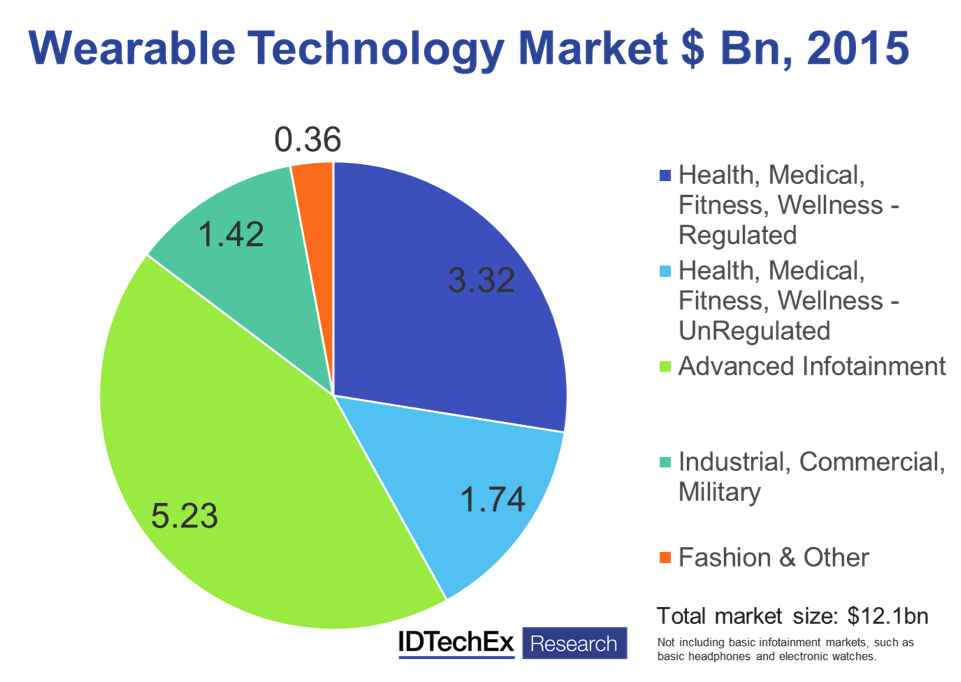



Feature Story
More feature stories by year:
2024
2023
2022
2021
2020
2019
2018
2017
2016
2015
2014
2013
2012
2011
2010
2009
2008
2007
2006
2005
2004
2003
2002
2001
2000
1999
1998
![]() Return to: 2015 Feature Stories
Return to: 2015 Feature Stories
CLIENT: IDTECHEX
July 13, 2015: IEEE Computing Now
Welcome to the inaugural post of IDTechEx: Emerging Technologies! We're honored to have the opportunity to be a part of the IEEE global community and share our ideas. As a forward-thinking, independent research and business intelligence organization, we're focused on a number of emerging technologies, including:
Given its rising popularity and expansion in the marketplace, we've decided to focus our first piece on one of today's hottest markets: wearables. Below you'll find some key trends, where the market's heading, a few examples of popular wearables and additional information about the unexplored opportunities in this market.
As traditional consumer electronics devices begin to saturate, new markets are being explored and foremost among them is wearable technology. However, wearable gadgets thus far are mixed in terms of their success — usually consisting of bulky electronics with many limitations, power being one of them.
According to new data from IDTechEx Research, the wearable technology market will rise from $24.2 billion in 2015 to three times that size in 10 years — creating a $74 billion market in 2025. In addition to an increasing demand for existing enabling components, this growth provides great opportunity for new technologies as electronics move from bulky, static devices to ones that can conform to the wearer.
By the way, you'll learn quite a bit more about this – and much more – at The IDTechEx Wearable USA event, an international conference and exhibition focusing on wearable technology requirements from big brands and industries, in addition to technology innovations that are enabling new products to meet those demands.
Since the beginning of 2013, there has been a 10-fold increase in Internet search interest, with approximately $1 billion invested in wearables in 2014 alone. This level of investment will rise as the largest companies in the world compete for a slice of a market.
The following chart highlights the 2015 split of wearable technology devices by revenue, excluding basic "infotainment" devices such as basic headphones and electronic watches.

Wrist-worn devices (under "Advanced Infotainment") are currently the most popular and publicized area in wearable technology. Smart watches in particular have been prominent in the media, culminating in the eagerly anticipated iWatch from Apple. Smart wristbands (such as the Fitbit Flex and Jawbone Up) have also become increasingly popular, with the market for fitness trackers being one of the key growth sectors. These devices pose a promising prospect for developers; they contribute to the ever-growing need to counter the global obesity epidemic without requiring lengthy and costly clinical trials. Therefore, the market has become competitive and the incorporation of a broader range of more reliable and accurate sensors is key to making a device stand out from the ever-increasing crowd.
Convergence to the wrist is a sensible first step for developers given the limitations in flexible and integrated electronics. The electric watch has been around for nearly 60 years, and typically has form factor and specifications that fit well with many traditional electronic devices. Sensors, for instance, are becoming increasingly versatile and mobile; energy harvesting and storage systems are becoming smaller and more efficient; and the use of e-textiles is emerging.
In most cases, the way forward is to abandon the century-old "components in a box" approach of almost all manufacturers of wearable technology today. Instead, structural electronics is key. This approach will create a cornucopia for manufacturers of electronic and electrically functional materials that can be made into structures using those increasingly crucial intermediate materials. Indeed, IDTechEx Research expects that in 2025, $25 billion will be spent on wearable technology formulations and intermediate materials.
The bottom line? Look for an array of emerging technologies which will allow developers to get creative as the wearables industry expands beyond the wrist!
Return to: 2015 Feature Stories